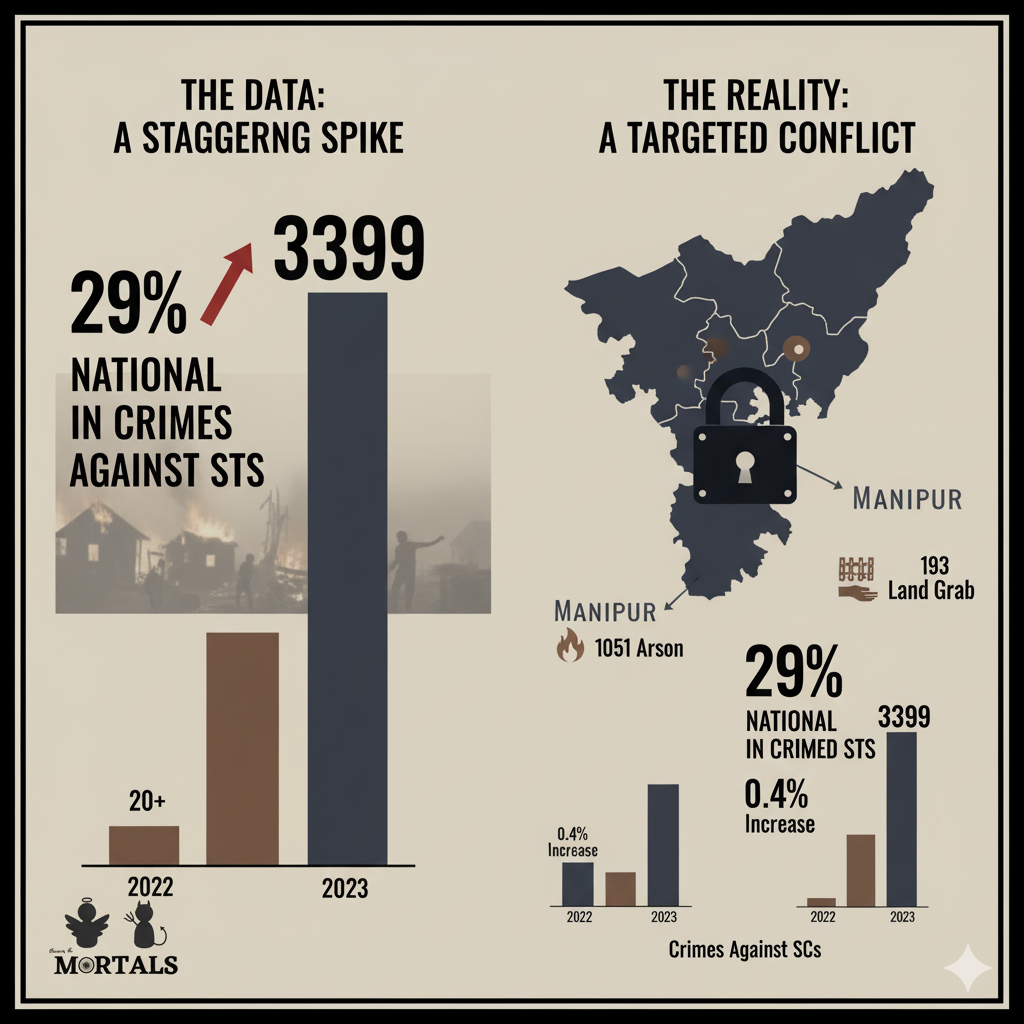For over a year, harrowing stories of violence have emerged from the conflict-torn state of Manipur. But now, the dry, official statistics have arrived to tell the most chilling and undeniable story of all. The latest “Crime in India” report from the National Crime Records Bureau (NCRB) for the year 2023 has put a number to the tragedy. It reveals a staggering 29% nationwide jump in crimes against Scheduled Tribes, with one state, Manipur, standing as the devastating epicenter of this violence. This case study delves into what these official numbers truly mean, not as mere statistics, but as a grim, quantitative record of a targeted ethnic conflict.
The Information Box
Syllabus Connection:
- Paper 2: Chapter 6.1 (Problems of Tribal Communities: Atrocities, Land Alienation), Chapter 9.3 (Ethnic Conflict)
- Paper 1: Chapter 4 (Political Anthropology: Conflict, State, Ethnicity)
Key Concepts/Tags:
- NCRB Data, Crimes Against STs, Ethnic Conflict, Manipur Violence, Kuki-Zo, Land Alienation, Atrocities
The Setting: Who, What, Where?
The data comes from the official “Crime in India” report for 2023, released by the National Crime Records Bureau (NCRB), a government agency. The geographical focus is the state of Manipur, and the context is the violent ethnic conflict between the valley-based Meitei community and the hill-based Kuki-Zo (Scheduled Tribe) communities, which began in May 2023. The core finding is that Manipur, which had negligible registered crimes against STs in previous years, suddenly accounted for 3,399 cases in 2023, driving a massive national surge.
The Core Argument: Why This Study Matters
This is a critical case study on using official data to understand the nature and scale of an ethnic conflict.
- Quantifying a Crisis: The NCRB data transforms the understanding of the Manipur crisis from anecdotal and journalistic to quantitative and official. The 28.8% national surge, driven almost entirely by the 3,399 cases in Manipur, provides an undeniable metric of the scale of the violence directed at the tribal population. It’s no longer just a story; it’s a statistic that demands accountability.
- The Anatomy of Ethnic Cleansing: The type of crimes recorded is profoundly significant. The staggering numbers for arson (1,051 cases) and illegal occupation/dispossession of land belonging to STs (193 cases) are not random acts of violence. In the context of an ethnic conflict, these specific crimes point towards a systematic and targeted effort at dispossession and creating a fait accompli on the ground—destroying homes and seizing land to make the return of the displaced tribal population difficult, if not impossible.
- Highlighting the Targeted Nature of Violence: The report provides a crucial point of comparison: while crimes against STs shot up by nearly 29%, crimes against Scheduled Castes saw only a marginal 0.4% increase. This statistical contrast is powerful evidence that the events of 2023 were not part of a general breakdown of law and order, but a specific, targeted, and exceptionally violent campaign directed against the Scheduled Tribes in a single conflict zone.
The Anthropologist’s Gaze: A Critical Perspective
- The Iceberg of Under-reporting: An anthropologist’s first critical question would be: as horrifying as these numbers are, how much do they hide? The NCRB data is based only on First Information Reports (FIRs) registered by the police. In a state gripped by ethnic conflict, where the state machinery and police force themselves are often accused of bias and complicity, it is almost certain that a vast number of crimes go unreported or un-registered. The official figure, therefore, is likely the tip of a much larger iceberg of suffering.
- Translating Legal Categories into Social Realities: The NCRB uses the dry, legalistic categories of the Indian Penal Code. An anthropological analysis would translate these categories into their real-world social meanings. In this context:
- “Arson” is not just burning a house; it is “domicide”—the deliberate destruction of a home and a way of life to prevent return.
- “Occupy/dispose of land” is the legal term for ethnic displacement and land alienation.
- “Intentional insult or intimidation” is a direct act of asserting ethnic dominance and enforcing social terror.
- Data as a Political and Legal Tool: Now that this data is officially published by a government agency, it becomes an incredibly powerful political tool for the Kuki-Zo community, human rights organizations, and legal advocates. They can now use the state’s own statistics to demand justice, petition for judicial intervention, and make their case for accountability on national and international forums. It transforms their narrative from “allegations” into “officially recorded facts.”
The Exam Angle: How to Use This in Your Mains Answer
- Types of Questions Where It can be Used:
- “Analyze the major problems faced by tribal communities in post-Independence India.”
- “Ethnic conflict in Northeast India is often rooted in issues of land and identity. Discuss.”
- GS-2 (Social Justice): “How can official data be used to assess the state of vulnerable sections and ensure accountability?”
- Model Integration:
- On Tribal Problems (Paper 2): “The extreme vulnerability of tribal communities to ethnic violence is starkly illustrated by the latest NCRB data for 2023. The report reveals a nearly 29% national surge in crimes against STs, overwhelmingly driven by the conflict in Manipur, which alone accounted for over 3,300 registered cases.”
- On Ethnic Conflict: “The nature of ethnic conflict often involves systematic dispossession, a fact substantiated by official data. The 2023 NCRB report on Manipur, for instance, details over 1,000 cases of arson and nearly 200 cases of illegal land occupation against STs, providing statistical evidence that points towards a targeted campaign of displacement.”
- For GS-2 (Social Justice): “Official data from bodies like the NCRB is a critical tool for diagnosing social crises and holding the government accountable. The 2023 report, highlighting a massive 29% jump in crimes against STs fueled by the Manipur violence, provides an undeniable statistical basis for assessing the failure of the state’s law and order machinery and the urgent need for intervention.”
Observer’s Take
Data has a way of cutting through the political noise and telling an unvarnished truth. Beyond the harrowing stories and the endless debates, the cold, hard numbers of the NCRB report have painted a devastating statistical portrait of the violence unleashed upon the tribal communities of Manipur in 2023. It is a record of a society torn apart, where crimes like arson and land grabbing became widespread tools of conflict. But the most chilling thought is the one an anthropologist would immediately have: these are only the reported crimes. The true scale of the suffering is likely far greater. This data, therefore, is not just a record of a tragic past; it is a critical, official baseline from which the long and arduous road to justice and accountability must now begin.





